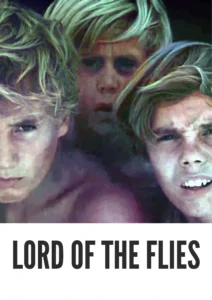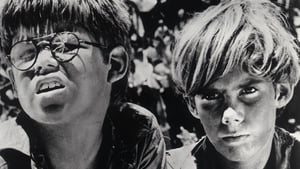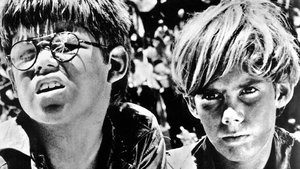Contact: info@alwanfilm.com
Video Sources 0 Views

Synopsis
Review: Lord of the Flies 1963 Colorized – A Cinematic Exploration of Civilization’s Collapse

Introduction
In the annals of cinematic history, few films capture the raw essence of human nature as viscerally as Lord of the Flies (1963). Directed by Peter Brook, this adaptation of William Golding’s seminal novel remains a powerful exploration of civilization, savagery, and the fragile veneer that separates the two. The 1963 film, shot in stark black and white, resonates with audiences even today, offering a haunting depiction of the breakdown of societal norms when a group of young boys is stranded on a deserted island. In this article, we will delve into the significance of Lord of the Flies (1963), examine its thematic depth, and explore its impact on the world of cinema.
Check The Full Colorized Movies List
Check Our Colorized Movies Trailer Channel
Understanding Lord of the Flies 1963 Colorized: Director, Cast, and Genre
Lord of the Flies (1963) is the brainchild of British director Peter Brook, a visionary filmmaker known for his experimental and boundary-pushing approach to cinema and theatre. Brook’s decision to adapt Golding’s novel was driven by his fascination with the book’s exploration of the darker sides of human nature and the disintegration of societal structures.
The film’s cast is composed of amateur actors, all of whom were boys chosen through an extensive casting process. This choice was deliberate, as Brook wanted to capture the raw, unfiltered performances of children who were not yet tainted by the conventions of professional acting. Among the standout performances is that of James Aubrey, who plays Ralph, the protagonist striving to maintain order amid the chaos. Tom Chapin’s portrayal of the antagonistic Jack brings a chilling intensity to the character, embodying the primal instincts that emerge when societal rules are stripped away. Hugh Edwards, playing Piggy, provides a poignant counterpoint, representing intellect and reason in a world descending into madness.
The genre of Lord of the Flies can be classified as a psychological drama and adventure, but its impact transcends these labels. It is a film that delves deep into the human psyche, exploring themes of power, fear, and the inherent violence that lies just beneath the surface of civilization.
Exploring the World of Lord of the Flies 1963 Colorized: Plot and Characters
At the heart of Lord of the Flies (1963) is a simple yet profoundly disturbing premise: a group of British schoolboys, stranded on a deserted island, must govern themselves in the absence of adults. What begins as an innocent adventure quickly spirals into a nightmare, as the boys’ attempts at self-governance unravel and their primal instincts take over.
The film follows the descent of the boys from civilized individuals to savage beings, driven by fear, power struggles, and the loss of their moral compass. Ralph, the elected leader, symbolizes order and democracy, striving to maintain the structures of society through the creation of rules and the establishment of a signal fire. However, he is gradually undermined by Jack, who represents the darker aspects of human nature—chaos, violence, and the lust for power.
As the story progresses, the conflict between Ralph and Jack intensifies, leading to the fragmentation of the group and the rise of savagery. Piggy, with his intellectualism and adherence to logic, becomes a tragic figure, ultimately meeting a violent end as the boys’ descent into barbarism reaches its zenith. The character of Simon, who represents innocence and spiritual purity, experiences a harrowing fate as well, further emphasizing the film’s exploration of the loss of innocence and the inherent brutality of mankind.
The Art of Film Colorization
Film colorization, the process of adding color to black-and-white footage, is an art form that has sparked considerable debate within the film community. It involves using technology to add color to films that were originally shot in black and white, a process that can alter the visual and emotional impact of the original work.
In the case of Lord of the Flies (1963), colorization has been a topic of discussion, particularly in terms of whether it would enhance or detract from the film’s stark and haunting atmosphere. The original black-and-white cinematography by Tom Hollyman is integral to the film’s unsettling mood, emphasizing the starkness of the island setting and the boys’ descent into savagery.
Early Colored Films: A Brief History
The history of film colorization is a journey through technological innovation and artistic experimentation. Early attempts at adding color to films date back to the silent era, where individual frames were painstakingly hand-painted to achieve a desired effect. As technology advanced, so did the methods of colorization, with techniques like tinting and toning becoming popular in the early 20th century.
The advent of Technicolor in the 1930s revolutionized the industry, allowing for more vibrant and realistic color films. However, for many directors, including Peter Brook, black and white remained the preferred medium for certain projects, as it offered a distinct aesthetic that could convey mood and emotion in ways that color could not. Lord of the Flies (1963) is a prime example of a film where the choice of black and white was essential to its thematic and visual impact.
Lord of the Flies (1963) and Its Early Colored Version
The idea of colorizing Lord of the Flies (1963) brings up interesting questions about the film’s visual narrative. While no official colorized version of the film exists, the concept invites speculation on how such a change might alter the audience’s experience. Would the lush greens of the island’s foliage, the blues of the sea, and the warm tones of the boys’ skin add a new dimension to the story, or would it detract from the film’s original stark and unsettling atmosphere?
The black-and-white cinematography of Lord of the Flies is not just a stylistic choice but a crucial part of the film’s thematic exploration. The absence of color strips the island setting of its potential idyllic beauty, turning it into a desolate, almost alien landscape that mirrors the boys’ psychological state. The stark contrasts between light and shadow heighten the sense of tension and impending doom, elements that might be diluted by the introduction of color.
The Debate Over Film Colorization
The debate over film colorization is a long-standing one, with strong arguments on both sides. Proponents of colorization argue that it can make classic films more accessible to modern audiences, particularly younger viewers who may be less inclined to watch black-and-white movies. They also suggest that colorization can enhance the storytelling by adding a new layer of visual information.
On the other hand, critics of colorization argue that it can compromise the artistic integrity of the original work. Many directors, including Peter Brook, chose black and white deliberately for its aesthetic and thematic implications. Colorization, in their view, risks altering the film’s mood, tone, and impact, potentially leading to a superficial reinterpretation of the original intent.
In the case of Lord of the Flies (1963), the decision to colorize the film would likely be met with resistance from purists who value the original black-and-white aesthetic. The film’s power lies in its starkness, its ability to strip away the distractions of color and focus the viewer’s attention on the raw, primal emotions at play.
Examining Lord of the Flies (1963) as an Early Colored Film
Hypothetically examining Lord of the Flies (1963) as an early colored film allows us to explore how color might alter the film’s visual and emotional landscape. While the original black-and-white version emphasizes the desolation and bleakness of the boys’ situation, a colorized version could bring out the natural beauty of the island, creating a striking contrast between the idyllic setting and the horror of the boys’ descent into savagery.
However, this contrast might also undermine the film’s thematic impact. The absence of color in the original version strips away any potential romanticization of the island, presenting it instead as a hostile environment where civilization unravels. The use of black and white serves to highlight the film’s exploration of the duality of human nature—the thin line between civilization and savagery.
A colorized version might also affect the portrayal of key scenes, such as the brutal killing of Simon. In the original film, the stark black-and-white imagery heightens the horror of the act, reducing the boys to mere silhouettes against the darkness, emphasizing the loss of their humanity. Color might soften this impact, making the scene more visually palatable but less emotionally harrowing.
Influence and Legacy: Lord of the Flies 1963 Colorized’s Impact on Cinema
Lord of the Flies (1963) has had a profound impact on cinema, influencing filmmakers and audiences alike with its unflinching portrayal of human nature’s darker side. The film’s exploration of themes such as the fragility of civilization, the allure of power, and the ease with which order can descend into chaos has resonated with viewers for decades.
The film’s influence can be seen in subsequent works that explore similar themes, such as The Beach (2000), directed by Danny Boyle, and Battle Royale (2000), directed by Kinji Fukasaku. Both films depict groups of individuals isolated from society and forced to confront their primal instincts, echoing the central premise of Lord of the Flies.
Moreover, Lord of the Flies (1963) has been cited as an inspiration by filmmakers like Martin Scorsese and Steven Spielberg, who have praised the film for its bold storytelling and psychological depth. Its legacy extends beyond the world of cinema, influencing literature, theater, and even television, with countless adaptations and reinterpretations of Golding’s novel continuing to emerge.
Director’s Cinematic Legacy: Beyond Lord of the Flies 1963 Colorized
Peter Brook’s cinematic legacy extends far beyond Lord of the Flies (1963), encompassing a body of work that spans film, theater, and opera. Known for his innovative and experimental approach to storytelling, Brook has been a pioneering force in the arts for decades.
After Lord of the Flies, Brook continued to push the boundaries of traditional narrative forms, directing films such as Marat/Sade (1967), which explores the intersection of politics, madness, and revolution. His work in theater is equally influential, with productions like The Mahabharata (1985) and A Midsummer Night’s Dream (1970) earning critical acclaim for their bold reinterpretations of classic texts.
Brook’s influence on cinema is evident in his commitment to exploring complex themes and challenging conventional storytelling techniques. His work has inspired generations of filmmakers to think outside the box, to question the status quo, and to embrace the power of visual and narrative experimentation.
Themes Explored in Lord of the Flies 1963 Colorized
Lord of the Flies (1963) is a film rich in thematic content, exploring the fragility of civilization, the nature of power, and the inherent darkness within the human soul. At its core, the film is a meditation on the thin veneer that separates order from chaos, civility from barbarism.
The film’s exploration of power dynamics is particularly striking, as it portrays how easily authority can be corrupted and how quickly societal structures can collapse in the absence of established norms. The struggle between Ralph and Jack serves as a microcosm of the broader human experience, highlighting the eternal conflict between the forces of order and the forces of anarchy.
Another central theme of the film is the loss of innocence. The boys, initially excited by the prospect of freedom on the island, gradually succumb to their basest instincts, shedding the trappings of civilization as they embrace savagery. This descent into barbarism is depicted with unflinching realism, emphasizing the ease with which humanity can revert to its primal state.
Reception and Controversy Surrounding Lord of the Flies 1963 Colorized
Upon its release, Lord of the Flies (1963) was met with a mixed reception. While some praised the film for its bold and uncompromising depiction of human nature, others found its portrayal of violence and savagery disturbing. The film’s stark black-and-white aesthetic, coupled with its use of non-professional actors, contributed to its raw and unsettling atmosphere.
Over time, however, the film has come to be recognized as a classic of 1960s cinema, lauded for its psychological depth and its unflinching exploration of the darker aspects of the human psyche. The film’s themes of civilization versus savagery and the loss of innocence have resonated with audiences across generations, solidifying its place in the cinematic canon.
Where to Watch Lord of the Flies 1963 Colorized Online
For those interested in experiencing the haunting brilliance of Lord of the Flies (1963), the film is available on various streaming platforms. Whether you choose to watch it in its original black-and-white format or hypothetically consider what a colorized version might look like, the film remains a powerful exploration of human nature that is as relevant today as it was over half a century ago.
FAQs About Lord of the Flies 1963 Colorized
Q: Is Lord of the Flies (1963) faithful to the novel?
A: While the film stays true to the central themes and narrative of Golding’s novel, it takes certain liberties in its adaptation. Peter Brook’s minimalist and experimental approach adds a unique flavor to the story, emphasizing the psychological and emotional aspects of the boys’ descent into savagery.
Q: Why was the film shot in black and white?
A: The decision to shoot Lord of the Flies (1963) in black and white was likely driven by both aesthetic and thematic considerations. The stark contrasts of black and white enhance the film’s mood, highlighting the bleakness of the island and the boys’ gradual descent into barbarism. It also aligns with Peter Brook’s preference for a raw, unfiltered portrayal of the story.
Q: What is the significance of the conch shell in the film?
A: The conch shell in Lord of the Flies serves as a symbol of order, civilization, and authority. It represents the boys’ initial attempts to establish rules and maintain a sense of community on the island. As the story progresses and the shell loses its influence, it symbolizes the breakdown of order and the descent into chaos.
Conclusion
Lord of the Flies (1963) is a film that continues to captivate and disturb audiences with its unflinching portrayal of the darker aspects of human nature. Through its stark black-and-white cinematography, raw performances, and exploration of themes such as the fragility of civilization and the loss of innocence, the film remains a powerful and timeless work of cinema.
Whether viewed in its original form or imagined in a colorized version, Lord of the Flies (1963) challenges viewers to confront the primal instincts that lie beneath the surface of civilization. As we reflect on the film’s enduring legacy, it serves as a reminder of the thin line that separates order from chaos and the importance of understanding the complex nature of human behavior.





